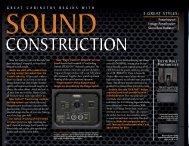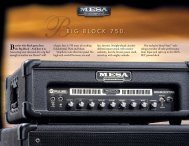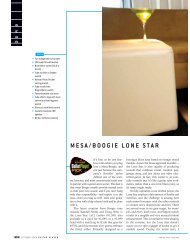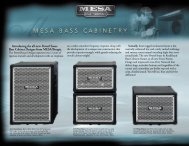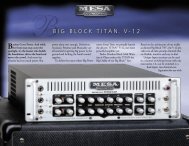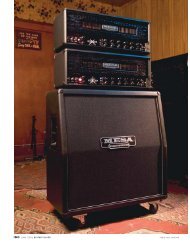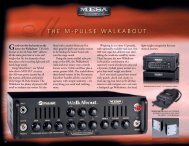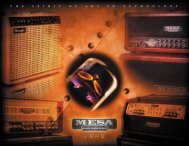Road King Manual - Mesa Boogie
Road King Manual - Mesa Boogie
Road King Manual - Mesa Boogie
- No tags were found...
You also want an ePaper? Increase the reach of your titles
YUMPU automatically turns print PDFs into web optimized ePapers that Google loves.
BIAS ADJUSTMENT: (part of a continuous series)An Article written by Randall Smith thatwe thought you might find interesting.Here’s a question we often hear:CATHODE ( )GRID ( , )SCREENGRID ( )..... .. .. .. .. ...BEAM-CONFININGELECTRODEPLATE( , )( )“Why doesn’t <strong>Mesa</strong> put bias adjustmentsin their amplifiers?”Well, there’s a short answer and a long answer to this question.Structure of a 6L6 / 5881Beam Power Pentode.The short answer is that during my 12 years of repairing Fenders, one of the most frequent problems I saw was bias controls that wereeither set wrong or that had wandered out of adjustment due to vibration. As any honest tech will tell you, there’s lot’s of easy moneyto be made by sprinkling “holy water” on amplifiers ... uh, what I meant to say is “Your amp needed biasing.” See what I mean? Whatcustomer is going to argue with that?It only takes a moment and a volt meter: The Fender diagram shows how: “Adjust this trim pot for - 52 volts.” That’s it. Nothing more.Now don’t be fooled into thinking that tubes “draw” more or less bias, they don’t. The way a bias supply is connected to a tube is akinto a dead end road, it just trails off to nowhere without really completing a circuit. It’s a static voltage and regardless of what tube is inthe socket — or even if the tubes aren’t plugged in at all, it doesn’t change the bias voltage a bit.So the end of the short answer is this: Since a bias supply needs to put out the right voltage and never vary, I wanted to buildamplifiers that were individually hard wired to the correct values and NEVER needed adjustment. And for 25 years, that’s how MESA/<strong>Boogie</strong>s have been built.Time to change tubes? Just plug our tubes into any one of our amps and you’re DONE. No tech needed. NO bills and no BS aboutbiasing. And most important: The bias is RIGHT because it can’t change!Now, you want the long answer? Here’s more information on how our hard-wired bias avoids trouble. Please read on.But first, let’s make an important distinction. Our business is designing and building high performance amplifiers. And for this we needtubes whose variance is within a narrow range. Our warehouse is full of rejects ...oh, they work — they just don’t perform within ourtolerance range. We have a very sophisticated computer - based tube testing system (nicknamed “Robotube”) that matches andmeasures tubes over seven important parameters. It can even predict which tubes are likely to have a shortened lifetime — eventhough they work perfectly during the test.Because our business is building quality amps, we can afford to reject a lot of wayward tubes. The guys you hear complainingbecause <strong>Boogie</strong>s don’t have bias adjusters are primarily in the business of selling tubes - not amps. They don’t want to throw away 30percent of their inventory, so they promote the idea that tubes outside our parameters can be used to “customize” amplifiers and theycriticize us because our amps can’t be adjusted to accommodate their out-of-MESA tolerance tubes.Now you might be thinking, “But I thought you just said that tubes don’t “draw” bias, therefore they don’t effect the bias supply and thusit doesn’t need to be adjustable.” When you set the bias (whether it’s by selecting the right resistors, as we do, or adjusting a trimmer— which is quicker) what you are doing is establishing the correct amount of idle CURRENT that flows through the power tubes. Butyou can’t adjust the current directly, you can only change it by adjusting the amount of bias VOLTAGE that goes onto the tubes’ controlPAGE 35




